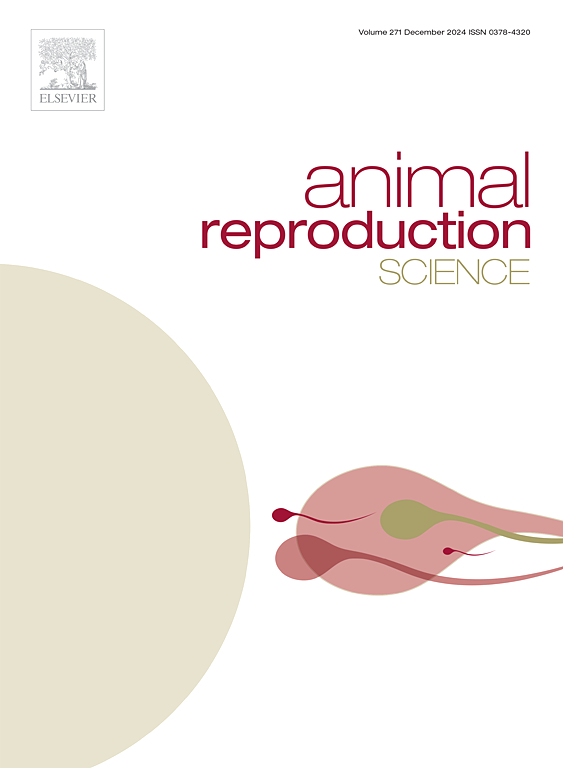公猪的生殖生理:是什么决定了射精的潜在生育能力?
IF 2.2
2区 农林科学
Q1 AGRICULTURE, DAIRY & ANIMAL SCIENCE
引用次数: 0
摘要
尽管对用于人工授精(AI)和其他辅助生殖技术的精液进行了数十年的研究和处理,但仍有 5-10%的精选公猪被认为是次精子,无法通过当前的精子质量和抗保存能力评估方法进行评估。作为最终产品,射精(依次暴露于复合精浆(SP)的发射精子)应确定睾丸、附睾和附属性腺的平衡。然而,将射精中的发现与精子生成生物学和生育能力联系起来的做法并不理想。本文对能繁育公猪的射精如何帮助我们诊断生殖健康和对精液处理的适应性进行了批判性评述,重点是现有和正在开发的方法,以确定低温耐受性和繁殖力的合适生物标志物。大量 SP、精液蛋白和微小核糖核酸(miRNA)虽然与人工授精后的精子功能和繁殖力有关,但在商业水平上却未能提高繁殖结果,这可能是因为它们只是复杂功能途径的组成部分。因此,现在的重点是精子与卵子之间的相互作用,将体内与体外进行比较,并优先考虑纳米大小的脂质双分子层精液胞外囊泡(sEVs)。sEVs 运送脆弱的分子(脂质、蛋白质、核酸),这些分子可避免降解,介导细胞与精子和女性内生殖道之间的交流。这种相互作用调节着从精子稳态到雌性免疫耐受等重要的生殖过程。SEVs 可被收获、鉴定、储存和处理,例如可用于生殖系统诊断和种鸡选择,也可用作添加剂以提高低温存活率和繁殖力。本文章由计算机程序翻译,如有差异,请以英文原文为准。
Reproductive physiology of the boar: What defines the potential fertility of an ejaculate?
Despite decades of research and handling of semen for use in artificial insemination (AI) and other assisted reproductive technologies, 5–10% of selected boar sires are still considered sub-fertile, escaping current assessment methods for sperm quality and resilience to preservation. As end-product, the ejaculate (emitted spermatozoa sequentially exposed to the composite seminal plasma, the SP) ought to define the homeostasis of the testes, the epididymis, and the accessory sexual glands. Yet, linking findings in the ejaculate to sperm production biology and fertility is suboptimal. The present essay critically reviews how the ejaculate of a fertile boar can help us to diagnose both reproductive health and resilience to semen handling, focusing on methods -available and under development- to identify suitable biomarkers for cryotolerance and fertility. Bulk SP, semen proteins and microRNAs (miRNAs) have, albeit linked to sperm function and fertility after AI, failed to enhance reproductive outcomes at commercial level, perhaps for just being components of a complex functional pathway. Hence, focus is now on the interaction sperm-SP, comparing in vivo with ex vivo, and regarding nano-sized lipid bilayer seminal extracellular vesicles (sEVs) as priority. sEVs transport fragile molecules (lipids, proteins, nucleic acids) which, shielded from degradation, mediate cell-to-cell communication with spermatozoa and the female internal genital tract. Such interaction modulates essential reproductive processes, from sperm homeostasis to immunological female tolerance. sEVs can be harvested, characterized, stored, and manipulated, e.g. can be used for andrological diagnosis, selection of breeders, and alternatively be used as additives to improve cryosurvival and fertility.
求助全文
通过发布文献求助,成功后即可免费获取论文全文。
去求助
来源期刊

Animal Reproduction Science
农林科学-奶制品与动物科学
CiteScore
4.50
自引率
9.10%
发文量
136
审稿时长
54 days
期刊介绍:
Animal Reproduction Science publishes results from studies relating to reproduction and fertility in animals. This includes both fundamental research and applied studies, including management practices that increase our understanding of the biology and manipulation of reproduction. Manuscripts should go into depth in the mechanisms involved in the research reported, rather than a give a mere description of findings. The focus is on animals that are useful to humans including food- and fibre-producing; companion/recreational; captive; and endangered species including zoo animals, but excluding laboratory animals unless the results of the study provide new information that impacts the basic understanding of the biology or manipulation of reproduction.
The journal''s scope includes the study of reproductive physiology and endocrinology, reproductive cycles, natural and artificial control of reproduction, preservation and use of gametes and embryos, pregnancy and parturition, infertility and sterility, diagnostic and therapeutic techniques.
The Editorial Board of Animal Reproduction Science has decided not to publish papers in which there is an exclusive examination of the in vitro development of oocytes and embryos; however, there will be consideration of papers that include in vitro studies where the source of the oocytes and/or development of the embryos beyond the blastocyst stage is part of the experimental design.
 求助内容:
求助内容: 应助结果提醒方式:
应助结果提醒方式:


